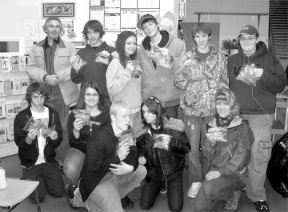Eating healthy on South Whidbey is big. Produce departments in South End grocery stores have an array of fresh, organic fruits and vegetables.
Yet for nearly 13 percent of the South End’s population these fresh, healthy foods may be out of reach. In the shopping bags of economically distressed families, you’re more likely to find canned foods, white breads and processed meat and cheese.
Why? It’s cheaper.
But poor nutrition also results in bad health and obesity.
One South Whidbey High School class and Good Cheer is working to combat the problem.
South Whidbey High School’s Community Leadership and Resiliency class delivered their first greenhouse harvest to Good Cheer Food Bank Tuesday morning.
The kids delivered about 48 sandwich bags full of lettuce. Only one day later, 2/3 of the bags had already been distributed.
“Our clients love fresh produce,” said Kathy McLaughlin, Good Cheer executive director.
With help from the Langley Community Club and the South Whidbey School District, the class repaired and prepared the old greenhouses at Langley Middle School and planted mixed greens as their first crop. They then packaged them in individual servings and delivered them to the food bank.
“In the spring we’ll grow additional crops,” said teacher Chris Burt.
Kimmer Morris, an assistant from the Learning and Community Engagement Project, guided the students in different gardening methods, such as double-digging the beds.
“While the leaves were little and the harvest a bit small, the food bank was so grateful for our donation. Families on South Whidbey who haven’t been able to afford to buy fresh produce will have a meal with fresh, locally grown greens. The students were so proud when we brought in the baggies,” Morris said.
Despite snow and many days of below freezing temperatures, the greens survived without grow lights or a heat source.
Taylor Judd, a student who recently moved to South Whidbey, loves the class.
“It’s one of the best classes there is because we get to learn new things and give back to the community at the same time. You not only grow food, you grow yourself,” she said.
The Good Cheer team is happy to get a load of fresh food in the winter when the immune system needs the most vitamins to fight off colds.
“We very much appreciate fresh produce at this time of year,” McLaughlin said. “It’s a joy seeing our local youth helping people in need in our community.”
“There has been lots of media hype about the poor not eating healthy food. We are so fortunate to be living in a community that is addressing this issue with a hands on learning project through our local school district. Students growing fresh produce for the food bank clients in their community in another example of service learning at its best,” she added.
The idea of community sponsored and supported agriculture or gardens is near and dear to McLaughlin’s heart.
At the food bank’s new location at Bayview, volunteers hope to start a community garden. Food bank officials also encourage hobby gardeners or professional growers to plant a little patch for the food bank. Fresh food could make a difference in somebody’s health.
When it comes to healthy eating, economics is often left out of the equation, McLaughlin said.
It’s cheaper to eat energy-dense foods rich in starch, sugar or fat than to eat lean meats and fresh produce.
Places like the food bank, which buys in bulk, struggle with keeping fresh foods in stock or fresh. Low-income families also fear wasting fresh foods.
The issue goes far beyond the borders of Whidbey Island.
Jamillah Jordan, a fellow with the Congressional Hunger Center in Washington, D.C., shopped for fresh groceries and discovered what those on limited incomes know well: Even the basics cost families a little more than food stamp benefits allow. And the first thing to go may be fresh or spoilable foods.



